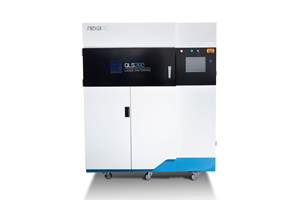In the Cold and Dark, TPE Molder Helps Turn the Power Back On
Storm clouds that gathered over Quebec in January 1998 held the proverbial silver lining for an innovative molder in the town of St-Jean-sur-Richelieu.
In the Cold and Dark, TPE Molder Helps Turn the Power Back On
Storm clouds that gathered over Quebec in January 1998 held the proverbial silver lining for an innovative molder in the town of St-Jean-sur-Richelieu. The ice storm struck on January 5th and ended four days later. The event crippled power lines in the region. To repair the damage, Quebec's only utility company, Hydro-Quebec of Montreal, needed lots of new insulation housings for its power-distribution lines—and it needed them fast. Waiting for production of standard thermoset or ceramic insulators would have kept the lights out for quite a while. So Hydro-Quebec used a local supplier with a new solution that had not been used before in North America.
Outrunning the competition
The utility asked GLP Hi-Tech Power Products Inc. to leap into mass production of its new dead-end composite insulator encapsulated with a thermoplastic elastomer. "We produced 31,000 units in 17 days, working 12-hour days," says Serge Gagne, president of GLP Hi-Tech. It was the firm's first order for the product, which GLP produces in lengths from 13.1 to 22.6 in. and weights from 1.7 to 2.3 lb. It features an overmolding of Dytron XL, a non-halogenated,flame-retardant compound of polypropylene with dynamically vulcanized rubber and alumina trihydrate. Dytron XL is made by Advanced Elastomer Systems, L.P., Akron, Ohio. Until recently it was marketed actively only in Europe.
About 60% of power-distribution lines currently use insulators with injection molded coverings of thermoset liquid silicone rubber (LSR), and another 15% are thermoset EPDM rubber, says Gagne. TPE in this application, at present used solely by GLP, makes up less than 1% of the market. But Gagne says use of its products has grown faster than expected. "It's a huge market. If we can reach 2% of the global market, it would represent a lot of pounds of TPE," he says.
"Hydro-Quebec had tried LSR as an electrical insulator in the 1980s but dropped it after 10 years. LSR was reliable in handling the voltages but did not meet expectations that it would last 25 years," Gagne says.
According to AES, the TPE has a self-cleaning effect, and it is the first product used in this application to pass the stringent FVO flammability test, as well as the 1994 and 1996 tracking-wheel tests, two measures of insulator performance in pollution and salt-spray conditions. TPE insulators reportedly have a 25-year life.
A TPE insulator can also be produced faster than an insulator of LSR, EPDM, cast epoxy, or porcelain. "There is no curing time or secondary operations with TPE like there are for LSR," says Gagne. "We can deliver an insulation system three to four times faster than any other product." All GLP needs for its production is a two-cavity mold on one 300-ton Nissei injection press. Although Dytron XL is more expensive than LSR, rapid production helps make it competitive.
Proven in the field
Since the '98 storm, Hydro-Quebec has installed 90,000 GLP insulators and has experienced no electrical or mechanical failures. The TPE units are used on distribution wires, where voltages typically run from 13 to 69 kV. Transmission wires, which carry electricity from the power plant to the distribution plants, support 115 to 735 kV and are insulated with LSR (under 500 kV), porcelain, or glass.
Before developing its insulators, GLP was familiar with TPEs in more than two decades of injection molding components for marine applications such as the Sea-Doo water craft, an underwater camera for Sony, and automotive and aerospace uses. To expand the market for its TPE insulators, the firm is researching the feasibility of extruding the insulation. This process would make it easier to add an overcoating with uv protection, which Castegan believes will be an attractive feature.
Faster production of TPE distribution-line insulators helped end a blackout emergency and launched a superior product, says Serge Gagne, president of GLP Hi-Tech Power Products.
Related Content
PIR/PCR Recycled Content and Biobased TPEs for Broad Range of Applications
NPE2024: Kraiburg TPE launching PCR/PIR content polyolefin-based TPEs and its expanded line of Thermolast R biobased TPEs.
Read MoreMedical Grade TPEs for Biopharmaceutical Tubing
Teknor Apex expands its Medalist TPE portfolio.
Read MoreFast-Cycling Selective Laser Sintering System
Nexa3D announced the QLS 260 for metal and polymer production.
Read MoreICIS Launches: Ask ICIS Generative AI Commodities Assistant
Said to be the first of its kind, this AI assistant will enhance access to ICIS’ intelligence and insights for the energy and chemical markets.
Read MoreRead Next
Making the Circular Economy a Reality
Driven by brand owner demands and new worldwide legislation, the entire supply chain is working toward the shift to circularity, with some evidence the circular economy has already begun.
Read MoreLead the Conversation, Change the Conversation
Coverage of single-use plastics can be both misleading and demoralizing. Here are 10 tips for changing the perception of the plastics industry at your company and in your community.
Read MoreBeyond Prototypes: 8 Ways the Plastics Industry Is Using 3D Printing
Plastics processors are finding applications for 3D printing around the plant and across the supply chain. Here are 8 examples to look for at NPE2024.
Read More





















